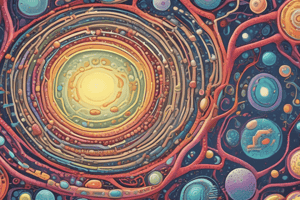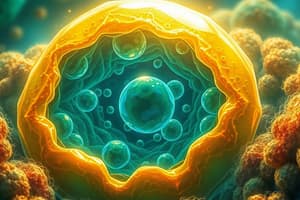Podcast
Questions and Answers
What is the primary function of the cell membrane?
What is the primary function of the cell membrane?
- To support the cell and regulate substance entry (correct)
- To provide energy to the cell
- To store genetic information
- To produce proteins
Which of the following cellular structures is responsible for producing energy?
Which of the following cellular structures is responsible for producing energy?
- Endoplasmic reticulum
- Mitochondria (correct)
- Chloroplast
- Vacuole
What is the significance of the vacuole in plant cells?
What is the significance of the vacuole in plant cells?
- It aids in photosynthesis
- It synthesizes enzymes
- It provides structural support and stores substances (correct)
- It regulates cell division
During which phase of mitosis do chromosomes align along the center of the cell?
During which phase of mitosis do chromosomes align along the center of the cell?
What is the role of lysosomes in a cell?
What is the role of lysosomes in a cell?
What distinguishes prokaryotic cells from eukaryotic cells?
What distinguishes prokaryotic cells from eukaryotic cells?
What defines a stem cell?
What defines a stem cell?
Which process describes the movement of water across a semi-permeable membrane?
Which process describes the movement of water across a semi-permeable membrane?
Which of the following is not a phase of interphase in the cell cycle?
Which of the following is not a phase of interphase in the cell cycle?
What type of cells can differentiate into almost all cell types in an organism?
What type of cells can differentiate into almost all cell types in an organism?
What is the primary purpose of cytokinesis?
What is the primary purpose of cytokinesis?
Which type of muscle tissue is responsible for involuntary movement in the walls of organs?
Which type of muscle tissue is responsible for involuntary movement in the walls of organs?
Which type of cell is primarily responsible for photosynthesis?
Which type of cell is primarily responsible for photosynthesis?
What is the primary function of connective tissue?
What is the primary function of connective tissue?
How many pairs of chromosomes do humans have?
How many pairs of chromosomes do humans have?
Which type of plant tissue is involved in photosynthesis and gas exchange?
Which type of plant tissue is involved in photosynthesis and gas exchange?
Which component of a microscope adjusts the amount of light reaching the specimen?
Which component of a microscope adjusts the amount of light reaching the specimen?
What type of cells can be generated from adult stem cells?
What type of cells can be generated from adult stem cells?
In which part of the heart does deoxygenated blood enter before moving to the lungs?
In which part of the heart does deoxygenated blood enter before moving to the lungs?
What is the role of platelets in the circulatory system?
What is the role of platelets in the circulatory system?
What does the alveoli's structure allow for in the respiratory system?
What does the alveoli's structure allow for in the respiratory system?
Which organ is responsible for producing bile to aid in fat digestion?
Which organ is responsible for producing bile to aid in fat digestion?
Which of the following is NOT a type of epithelial tissue function?
Which of the following is NOT a type of epithelial tissue function?
What major role does the xylem play in a plant?
What major role does the xylem play in a plant?
What part of the heart pumps oxygenated blood to the body?
What part of the heart pumps oxygenated blood to the body?
Which cells are part of the nervous tissue and transmit impulses?
Which cells are part of the nervous tissue and transmit impulses?
What drives the process of inhalation in the respiratory system?
What drives the process of inhalation in the respiratory system?
Flashcards
What is a Cell?
What is a Cell?
The basic, fundamental unit of life, capable of independent existence and carrying out all life functions.
Cell Division
Cell Division
The process by which a cell increases in size and eventually divides into two daughter cells.
Diffusion
Diffusion
The movement of molecules from an area of high concentration to an area of low concentration.
Osmosis
Osmosis
Signup and view all the flashcards
What is the Nucleus?
What is the Nucleus?
Signup and view all the flashcards
What is the Mitochondria?
What is the Mitochondria?
Signup and view all the flashcards
What is the Endoplasmic Reticulum?
What is the Endoplasmic Reticulum?
Signup and view all the flashcards
What are Ribosomes?
What are Ribosomes?
Signup and view all the flashcards
What is the Golgi Apparatus?
What is the Golgi Apparatus?
Signup and view all the flashcards
What is the Cell Wall?
What is the Cell Wall?
Signup and view all the flashcards
Photosynthesis
Photosynthesis
Signup and view all the flashcards
What is Mitosis?
What is Mitosis?
Signup and view all the flashcards
What is Interphase?
What is Interphase?
Signup and view all the flashcards
What is a Stem Cell?
What is a Stem Cell?
Signup and view all the flashcards
Potency
Potency
Signup and view all the flashcards
Pluripotent Stem Cells
Pluripotent Stem Cells
Signup and view all the flashcards
Totipotent Cells
Totipotent Cells
Signup and view all the flashcards
Meristematic Cells
Meristematic Cells
Signup and view all the flashcards
Hierarchy of an Animal
Hierarchy of an Animal
Signup and view all the flashcards
Tissues
Tissues
Signup and view all the flashcards
Epithelial Tissues
Epithelial Tissues
Signup and view all the flashcards
Connective Tissues
Connective Tissues
Signup and view all the flashcards
Muscle Tissues
Muscle Tissues
Signup and view all the flashcards
Skeletal Muscle
Skeletal Muscle
Signup and view all the flashcards
Smooth Muscle
Smooth Muscle
Signup and view all the flashcards
Cardiac Muscle
Cardiac Muscle
Signup and view all the flashcards
Nervous Tissue
Nervous Tissue
Signup and view all the flashcards
Organs
Organs
Signup and view all the flashcards
Organ System
Organ System
Signup and view all the flashcards
Digestive System
Digestive System
Signup and view all the flashcards
Study Notes
Cell Structure
- Cells are the fundamental units of life
- Cells exhibit various functions: movement, growth, respiration, excretion of waste, and energy production.
Cell Size
- Cells are generally similar in size
- As size increases, volume increases rapidly
- Large cells must divide to maintain efficiency
Unicellular vs. Multicellular Organisms
- Unicellular: Lower life forms, often found in extreme environments. Each cell performs all life functions. Examples: Paramecium, bacteria.
- Multicellular: Cells are specialized. Groups of cells perform specific tasks. Examples: plants, animals.
Prokaryotes
- Small and simple
- Lack a nucleus (nucleoid instead)
- Lacks membrane-bound organelles
- Cell walls present
- Examples: bacteria, cyanobacteria (blue-green algae).
Eukaryotes
- Complex
- Contain a nucleus
- Contain membrane-bound organelles
- Unicellular or multicellular
- Examples include animal and plant cells, fungi, protozoa.
Animal Cell Anatomy
- Includes, nucleus, mitochondria, vacuole, cytoplasm, microtubules, Golgi complex, ribosomes, endoplasmic reticulum, lysosomes, plasma membrane, rough endoplasmic reticulum, centrioles, vesicles, peroxisomes, nuclear pores, nucleolus.
- Additional organelles and components are listed.
Plant Cell Anatomy
- Includes, nucleus, nucleolus, rough endoplasmic reticulum, smooth endoplasmic reticulum, Golgi apparatus, cell wall, cell membrane, peroxisomes, chloroplasts, amyloplasts, mitochondria, vacuole, cytoskeleton.
- Specific organelles unique to plant cells, and components are listed
Cell Parts
- Cell Membrane: Flexible double-layered membrane that encloses the cell. Function is support and allows substances in and out.
- Cell wall: Rigid structure that gives plants shape and protection.
- Chloroplasts: Site of photosynthesis in plant cells.
- Vacuoles: Storage compartments for water, food, wastes, and other materials.
- Mitochondria: Powerhouses of the cell, produce energy.
- Nucleus: Control center of the cell, contains DNA.
- Ribosomes: Assemble proteins.
- Endoplasmic reticulum: Transports proteins and other materials.
- Golgi apparatus: Processes and packages proteins.
- Lysosomes: Contain digestive enzymes.
- Cytoplasm: Jelly-like substance filling the cell.
- Chromosomes: Contain DNA, and direct the activities of the cell
Diffusion
- A process of moving substances across the cell membrane from higher to lower concentration to equalize concentration.
- Critical for exchange of materials.
Osmosis
- The diffusion of water across a membrane, water moves from higher to lower concentration
Mitosis
- The process of cell division in eukaryotic cells, result in two genetically identical daughter cells.
- Steps are outlined in detail: Prophase, metaphase, anaphase, telophase, cytokinesis.
- Description and stages of mitosis
- Importance in cellular growth, repair and reproduction
Cytokinesis
- The division of the cytoplasm, following mitosis, to produce new daughter cells. Process differs between animal and plant cells.
Microscope
- A compound microscope has two lens systems: ocular lens and objective lens; to determine total magnification of an image, multiply the ocular lens power by the objective lens power.
- Methods to calculate specimen sizes based on microscope.
Microorganism Types
- Different types of single-celled organisms, including prokaryotes (lacking a nucleus and membrane-bound organelles) versus eukaryotes (containing a nucleus and membrane-bound organelles).
Specialized Cells
- The process by which cells develop to perform specific functions
- Types of cells: (animal versus plant) cell specialization as well as cells functions
- Stem cells: Undifferentiated cells with the potential to become specialized cells. Types of stem cells including Embryonic and Adult.
- Animal and plant cells and functions are listed.
- Various specialized cells in animals and plants with unique structures and functionalities
Circulatory System
- Function of blood (cells). The circulatory system.
- Components: arteries, veins, and capillaries, and their functions
- Details of the human heart
Respiratory System
- The organ system that brings oxygen into the body and allows carbon dioxide to leave
- Description of inhaled air path
- Function of the lungs
- How breathing works
- Diseases include tuberculosis, pneumonia, pleurisy, cancer, and emphysema.
Digestive System
- The digestive system, an organ system to processes food.
- Organ functions: mouth, esophagus, stomach, small intestine, large intestine, and associated organs (liver, pancreas, gall bladder)
- The digestive tract function
- Diseases such as colitis and diabetes are listed, and their relevance.
Studying That Suits You
Use AI to generate personalized quizzes and flashcards to suit your learning preferences.




